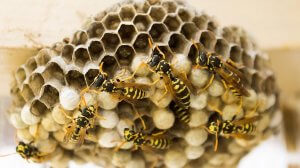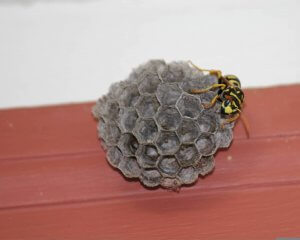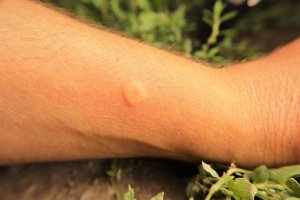Getting stung by a yellow jacket, probably one of the more predatory species of wasps from the family Vespidae, can be a serious matter, particularly to humans who may be allergic to the venom.
These insects have lance-like stingers with small barbs, and can sting multiple times during a single attack.
Their aggressive nature emanates from the fact that they are fiercely social and are known to attack with little or no provocation other than perhaps standing or passing too close to their nests.

The situation is even more dangerous to humans at the end of the summer when their populations are at their highest peak, and even into early Fall.
According to Sharon Collman, retired Washington State University entomologist, yellow jackets are so vicious that they are even known to squirt venom through a bee veil, aiming at the eyes of a person who is wearing it.
The Nature and Habitat Of A Yellow Jacket
Despite their instinctive distrust for people, their habitat is usually any place where humans live wherein lies the intrinsic conflict between yellow jackets, people and their dangerous nature.
Their nests are usually underground or inside hollow logs, attics, tree stumps, between walls, under eaves and inside recycling bins, which often retain traces of sugars, which they love.
Adults survive for only one season by feeding on caterpillars, grubs, other insects, nectar and sugary substances such as tree sap and fruit.
Their nests are large ovals, hidden away into brush or shrubbery or down by the soil level in an opening resembling a mouse burrow.
The nests are complex structures, and wood fiber is the most preferred material for their construction, which is chewed into a fine, thin pulp.

They are not always easy to find even for our pest-control experts because nest entrances can be as small as a nickel.
In hot, arid climes, yellow jackets do not venture further than about 1,000 feet from their nests to forage for food, which is roughly the size of three football fields.
Yellow jackets die out in cold weather. Only the queen overwinters, and she begins the nest anew each year. While some insects do, yellow jackets do not reuse their nests, making them safe to remove from property after populations have died.
The queen begins a new nest and feeds young larvae for about three weeks, when they emerge as worker wasps (infertile females).
The Yellow Jacket’s Place Within The Eco-System
Yellow jackets kill countless garden pests during their short lifetimes, which serves to balance Mother Nature’s order of things.
They also pollinate certain flowers and thrive on sweet nectar. Meat, garbage and picnic food left outside are also on the yellow jacket menu.
Unfortunately their life cycle coincides with a favored time of year for humans to enjoy the great outdoors, making conflict inevitable to a certain degree.
The Powerful Sting Of A Yellow Jacket
A yellow jacket will often bite the skin first in order to get a better grip, and then it pierces the flesh repeatedly with its nasty stinger. This causes the immediate release of toxic venom and sharp, sudden pain.
For many, a few hours after the sting-localized inflammation, itchiness and redness often occurs. Unlike bees, the stinger is never left inside the skin.

Severe pain and burning sensation at the affected site usually lasts from one to two hours, and swelling can increase for 48 hours afterwards and last for as long as a week. Redness is known to persist for about three days.
Our pest-control technicians warn that there are some symptoms to watch for that indicate the need to call 911 immediately to the scene.
These include: slurred speech; coughing or wheezing; problems breathing or swallowing or tightness in the throat; alterations to skin such as breaking out into hives; feeling light headed or passing out; vomiting or diarrhea.
The Severe Allergic Reaction Know As Anaphylaxis
The above-mentioned symptoms can indicate a grave condition known as anaphylaxis, which is a severe allergic reaction that can be fatal.
If you or someone in close proximity to you is experiencing any of them, you must act quickly until the emergency crew arrives.
If you have an Epi-Pen, inject it now. If not, notify 911 that none is available. Try to remain calm, as this may be a life and death situation.
The person who has been stung needs to lie down and feet should be raised to about 12 inches and covered with a blanket.
If there is vomiting or bleeding, turn the person over to one side. Loosen clothing so that breathing is not impeded.
Avoid administering liquids or lifting the head, especially if breathing is labored. If the person who was stung become unconscious, you may need to perform CPR.
Not All Yellow Jackets Are Equal
The sting of some species of yellow jackets cause more allergic reaction than others.
According to a study conducted Dr.David Golden, M.D., an associate professor of allergy and immunology at The Johns Hopkins University School of Medicine that was published in 2006 in the Journal of Allergy and Clinical Immunology:
“Because we’ve found that the severity of an allergic reaction is related to the species of yellow jacket, it’s important for people to understand that they can have wildly different reactions depending on which species stings them and that getting stung once without an allergic reaction does not guarantee that a more serious reaction will not happen with a later sting.”
General Advice About Treatment
Hopefully, the general procedures to follow after being stung that are suggested will require less dramatic steps.
They usually include:washing the wound carefully with soap and water, which will help remove the venom; applying ice or cold water in a wet cloth and taking a pain reliever or antihistamine if available.
5 Proactive Measures To Keep Yellow Jackets At Bay
Most important of all is the advisory that if you have any sensitivity to insect venom, don’t even think about attempting any form of pest control.
Limit Cooking Or Eating Outdoors In Late Summer & Early Fall
You can try to get around this by setting up yellow jacket traps that will distract them from barbecue and eating areas. Beer is a magnet for these insects because of the aroma emanating from the hops. That can be a drag, but considering that fact is better than getting stung.
Choose What You Wear To A Barbecue Wisely
Avoid wearing brightly colored, dark or patterned clothes to any summer picnics or BBQs. Opt for white or very light colors instead. Don’t wear scented talcs, hair spray, perfumes, cosmetics, colognes, or sun tan and shaving lotions to outdoor venues because these aromas attract yellow jackets.
Watch Out For Wet Towels And Wash-Cloths
Do not handle wet towels or wash cloths without first checking to make sure that yellow jackets aren’t drinking moisture from them.
Always Cover Food And Drinks That Are Left Outside
Never leave food in uncovered or open containers. Use a glass with a lid and a straw when drinking liquids outside as well.
Never Hit, Swat At Or Squash A Yellow Jacket
Such actions cause the release of chemical pheromones that summon other yellow jackets to the scene. The quick movements of hands, arms and legs can also serve as triggers for their aggression.
Get The Very Best Friendliest Yellow Jacket Pest Control!
If you see many yellow jackets milling around your Pittsburgh property, call our teams at Pestco as soon you can! We offer the friendliest and most effective pest control measures throughout all of Allegheny county!

 Over 300 Reviews
Over 300 Reviews 